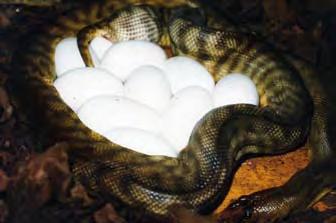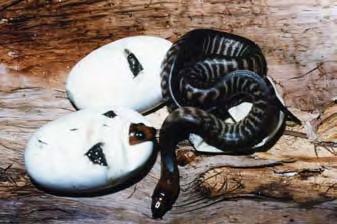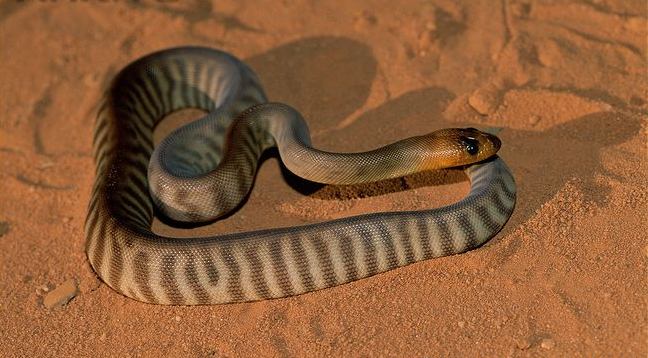Woma breeding: INTRODUCTION
by Peter Krauss (Originally published in Thylacinus in 1992. Reprinted in Monitor Vol 6 Issue 1 1994)
The Woma (Aspidites ramsayi) inhabits arid areas of the central and northern parts of Australia. At least two quite distinctive different forms of colouration and size occur in varying latitudes. Typically different examples are those from northern South Australia and those of the Tanami Desert in the Northern Territory. The northern form is cream with orange-brown bands, while the southern form is a uniform and drab brown colour. The northern Desert Woma reaches approximately 1.5m in length as an adult and the southern area form grows to double this size. Visually they bear little similarity as mature specimens.
A group of Womas in my care for over 16 years initially consisted of one male and two females with another male included later after the first successful breeding occurred in 1985. The animals are the desert form found in the Tennant Creek area of the Northern Territory, and were juveniles when obtained.
Woma breeding: FEEDING
As adults the male specimen measured 1.4m in length and weighed 1300g, while the females were 1.5m long and weighed 2000g and 2300g respectively. Food was always accepted readily and consisted mainly of laboratory rats, either freshly killed or defrosted. During a period some years ago, young goslings were available and the male especially preferred this change to his diet. No food was offered during winter and feeding was strictly controlled and monitored during the warmer months. Obesity is not healthy and is definitely to be avoided if the animals are to breed. Feeding is always supervised to avoid accidental cannibalism. Proper feeding is important in woma breeding.
Woma breeding: HOUSING
Over the years the Womas occupied several different cages. Being a terrestrial snake, the cage should be low and reasonably spacious. My Womas occupied a cage of 2m x 1m x 0.5m high with a removable dividing partition in the middle. The front was made of sliding glass panels, and the sides and back of peg board to provide ample ventilation. The top and floor were constructed of industrial plywood. As a substrate for the floor of the cage I found bark chips most suitable. These should be a medium grade and not dusty. A depth of 80-100mm as covering on the floor provided best.
Outside the mating season from August to April, I kept the male and females apart by dividing the cage into two sections. Feeding is also more easily supervised in this way. Each cage has its own hide box, a most important feature in any snake cage, and to completely fulfill its objective it must be correctly sized. When coiled up in this retreat, the python’s body should touch at least two opposite sides of the box, so that it feels secure. If two snakes occupy the cage, the hide box naturally needs to accommodate both specimens. The floor of the box is covered with paper to facilitate easy cleaning. This is an important factor to a successful woma breeding.
In addition the floor of each cage section has a cover which can be placed on top of the bark chips. This cover is constructed of wood and masonite and measures 800mm x 400mm x 100mm high. It is closed on three sides allowing access through one open narrow side. The snakes spend a great deal of time under these covers resting and keeping out of sight.
Each cage section has a 20 watt Vita-Lite lamp which is fitted to the back wall of the cage, approximately 200mm up from the floor. The hide box is also mounted to the rear inside wall of the cage and immediately above the light. Thus the warmth from the light heats the floor of the hide box and its close proximity to the floor provides ideal conditions for the effectiveness of the ultra-violet output of the light when the snake lays under it. As an additional heat source, each cage section is fitted with a 14 watt electrical heat pad which provides warmth for about 25% of the floor area. A successful woma breeding requires a sufficient space allocation.
Light and heating is controlled by a time clock without a thermostat installed. During the months of April to August, at least on alternate days, all Womas were exposed to a 300 watt Osram Ultra-violet Sunlamp. This light is fitted on a tripod and can be directed at the snake after sliding the glass panel aside. Exposure time is only about 5-10 minutes at a distance of about 600mm from the snake. This procedure has the added benefit of showing off the snake in the ver bright light and thus allowing a thorough visual inspection and examination.
Each cage section has a water container large enough for the Womas to lay in, but over many years I have never seen a Woma soak in water. Every 2-3 days the cage is sprayed with water and oftern it is then that the snakes drink directly from the nozzle of the pressure spray. Regular spraying of the substrate with water reduces the dust. Naturally the bark chips should be just slightly moist but never wet. Faeces, urine and sloughs are removed regularly.
The construction of the building containing the snake cages was such that it provided ultimate climatic conditions. During the hottest time of the year all heating was turned off and lighting was provided for only about three hours in the morning. The metal roof of the building had skylight panels built into approximately 15% of its area and thus the room becomes very hot.
During the summer months I had the roof covered with shade cloth and if necessary a sprinkler system on the roof was turned on. Temperatures range from 24°C minimum at night to 43°C maximum during the day. These temperature conditions reflected the climate experienced in my home district at the northern end of the Atherton Tablelands, approximately 60km inland from Cairns in north Queensland.

Woma breeding: HOW TO BREED
Usually during the first week of May I removed the cage divider to allow animals to be together. In most recent years when the young second male had reached well over one metre in length and weighed approximately 1200g, the older male, its father, frequently attempted to copulate with it.
Cloacae were pressed together in the usual way but no insertion of hemipenis was observed. There actions looked so realistic that I was prompted to check again that they were both males. Usually mating by the original male with one of the females occurred within hours of the divider being removed and lasted 6-8 hours. The male would then coil up by himself away from the females. At 38 months of age the young male was apparently not sexually mature, because it never showed sexual interest in the females. The adult male would always service both females, however, he seemed to favour one or the other at various times. When this was noticed I usually controlled access in order to ensure fertilization of both females.
If you're into woma breeding, you should know that these snakes are at times biennial breeders but there does not seem to be a regular pattern to this behaviour. Females seem to engage in mating activities with the male every year, but do not regularly develop eggs. They may breed in two consecutive years and then miss a year.
Each time a copulation with insertion of the hemipenis was clearly observed and noted I separated the male from the females again. After about 48 hours, reintroduction usually resulted in immediate mating once again. Copulation took place regularly from the first week in May until the first week in July. By this time very careful examination of the female Womas usually revealed egg development. Just by holding the snake and allowing it to move from one hand to the other with fingertips held against the belly, I was able to detect eggs forming.
One month later, if the female was gravid, egg shapes were visible. By early September the gravid Woma would rest with two thirds of her body either on its side or completely upside down. At this stage I provided an additional heat source with a 40 watt spotlight which was operated by time clock for three hours each morning. Particularly during the last weeks prior to egg laying the gravid snakes would often bask under this light for lengthy periods of time. I consider such a basking facility very important for the healthy development of the eggs. The female at this stage rests with her body partially upside down most of the day - and always at night the eggs had moved down to the lower part of the body.
As the latter half of September approached a site was selected by the female and prepared for egg laying. This usually happened under the cover on the floor of the cage. The snake started hollowing out a spot in the bark chips by moving her body in a circular motion. She moved all the bark chips aside and eventually rested on the cage floor. During the last days the female could often be heard thrashing with her body under the covers as she moved in a circular and concentric motion.
 The eggs were usually laid during the last week in September. The other female was often one month later with her developments. Egg numbers ranged from 8-10 and fertility was 90-100%. The process of actually laying the eggs took the female 2.5-3 hours with a clutch of eight eggs. Eggs averaged 85gm in weight and 78mm in length. In clutches of ten eggs weight and size were marginally less. The eggs were removed as they were laid for the purposes of incubation in an electric incubator. This was done after each individual egg had dried and before it became attached to another egg orto any substrate matter.
The eggs were usually laid during the last week in September. The other female was often one month later with her developments. Egg numbers ranged from 8-10 and fertility was 90-100%. The process of actually laying the eggs took the female 2.5-3 hours with a clutch of eight eggs. Eggs averaged 85gm in weight and 78mm in length. In clutches of ten eggs weight and size were marginally less. The eggs were removed as they were laid for the purposes of incubation in an electric incubator. This was done after each individual egg had dried and before it became attached to another egg orto any substrate matter.
My incubator was a modified Swan poultry incubator. It had an extra backup thermostat fitted and it featured a small electronic fan for air distribution. I am incubating most reptile eggs by the no-substrate method and find this the best way for my purposes. Eggs are placed on paper towelling on top of a mesh grid of plastic or stainless steel which is suspended over water, approximately 20-30mm deep, in a plastic container. This plastic container is fitted with an air tight lid which is transparent for easy observation of the eggs. Whilst I found it unnecessary to ever open the egg boxes, I did on occasions open the lid briefly and even changed the paper once or twice during the incubation period. This method maintains a steady 100% humidity at all times.
Experiments have shown that healthy embryos will survive and hatch even if bad and decaying eggs have not been removed. This seems especially remarkable if the container remains sealed during the entire incubation time. If all is well and the fan in the incubator functions constantly there should be very little or no condensation on the inside walls and lid of the egg boxes. If at any time an egg shows the typical signs of being dead it is advisable to remove it. This is no problem if eggs are harvested singularly and placed separately in the plastic box. If this is not possible and the eggs are in a clutch, where all are attached, it is wiser to leave a spoiled egg rather than risking damage to other eggs by trying to remove it.
At a temperature of 29-30° C, hatching started on the 75th day, however at 31° C, hatching began on the 60th day. The average weight of the neonates was 45gm and their length was 320mm. The young snakes slough for the first time after 10-12 days. They feed readily on pup mice and are best kept separately for better supervision and record keeping.
Woma breeding: CONCLUSION
The Woma is a snake which demands a lot of attention from its keeper. Working with this interesting python has been most gratifying over the years. My plans for second generation breeding, maternal incubation etc, will not be possible. Due to unfortunate circumstances these animals are no longer in my care.
Woma breeding: ACKNOWLEDGMENTS
To Malcolm Thompson for converting my scribbled notes into readable English and Brian Barnett and Simon Kortlang for reading the manuscript and making valuable suggestions. My former associates and partners Margit and Karin Cianelli made it possible to work with these animals in the first place and provided expert help over many years. Cam Whiteing skilfully drew the original sketches and Amy Andersen kindly typed the various drafts.


